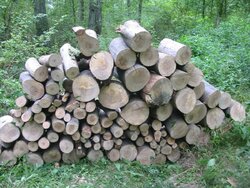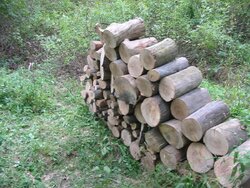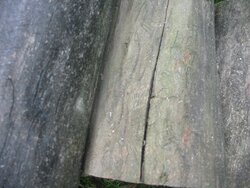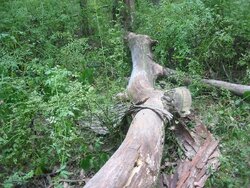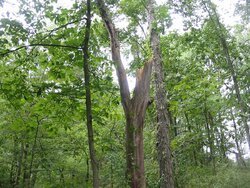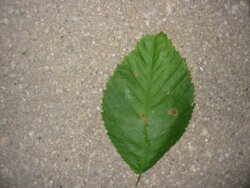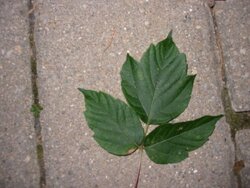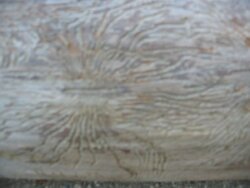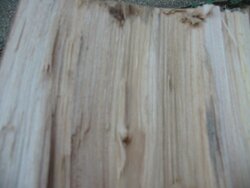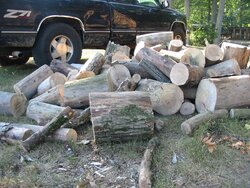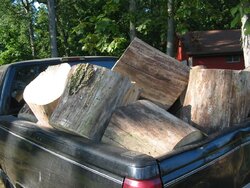I can't get out of the woods. Went to clear a tree off one of the paths and found this. This tree has been standing dead for a long long time. It has no bark and no punk and is dry dry. There is a lot of wood to this tree. I believe it is maple but not 100% sure. I will get the rest of what is on the ground but will leave the standing until later. This wood will be ready this fall.
Will Someone call a doctor
- Thread starter TimJ
- Start date
-
Active since 1995, Hearth.com is THE place on the internet for free information and advice about wood stoves, pellet stoves and other energy saving equipment.
We strive to provide opinions, articles, discussions and history related to Hearth Products and in a more general sense, energy issues.
We promote the EFFICIENT, RESPONSIBLE, CLEAN and SAFE use of all fuels, whether renewable or fossil.
You are using an out of date browser. It may not display this or other websites correctly.
You should upgrade or use an alternative browser.
You should upgrade or use an alternative browser.
- Status
- Not open for further replies.
thewoodlands
Minister of Fire
TimJ, nice find. My experience with dead standing like that is once I split it the m/c was around 25 percent, after one week inside during the burning season it dropped to 22 percent. I'm not sure what type of wood I had.
zap
zap
Backwoods Savage
Minister of Fire
Tim, I think you have found yourself some nice elm. This is the way to get it too; that is, when the bark has all fallen off. Makes much better firewood now because it won't split all stringy.
Dennis, I wish it was elm. Near this fallen barkless tree are two big dead red elms just like the one I got in the spring. Both are barkless, and I can now fully recognize them,
I took the maul out to these rounds and had a go at them. Unfortunately, everything can't fall into my lap. It took 7 healthy swings before I got a round to start to split. I still believe it is maple.
I took the maul out to these rounds and had a go at them. Unfortunately, everything can't fall into my lap. It took 7 healthy swings before I got a round to start to split. I still believe it is maple.
Flatbedford
Minister of Fire
The way your pictures come up, it looked like you found a stack of cut wood off one of the paths!
Shadow&Flame
Minister of Fire
The way your pictures come up, it looked like you found a stack of cut wood off one of the paths!
That is what I thought at first as well. Figured it was a tree he had cut up before and forgotten about...I have done that...

Thistle
Minister of Fire
nrford
Minister of Fire
I believe Dennis hit the nail on the head. Six months ago if someone would have asked me if I had elms on my property I would have said no. Then I discovered I have many elms.................all red. At least that is what I thought. I went down to this area. It looks like the cut wood is on a path but it is not. It is just an area that water runs through in the spring and heavy rains. Studied the dead tree a bit and found two more dead ones not anywhere near the size dead as well. This tree is about 36" DBH There are also a couple live ones. I pulled the leaves off of one and also a red elm and have the leaf pictures below. I also brought up a nice clean round and I could not split it hitting it three times.The maul bounced off. Now I believe this is an elm. However, the leaf does not look like American elm.
Below, red elm leaf to the left, other elm to the right.
What is it
Thanks
Below, red elm leaf to the left, other elm to the right.
What is it
Thanks
Attachments
I was also going to cut the hole thing down and rent a splitter for a day and when I went to the tree this eve discovered it is about a foot on the other side of my property line. The farmer next to me has one of those outside wood burning huts ( don't know the real name )
I'm suprised he hasn't gotten it although I know those things burn wet wood
I'm suprised he hasn't gotten it although I know those things burn wet wood
Thistle
Minister of Fire
S
ScotO
Guest
talk to him, see if you can drop the tree. Maybe he'll have a splitter he can loan you, you split up the tree and give him half of the load. It may lead to more shared wood from his property. Just a thought.....I was also going to cut the hole thing down and rent a splitter for a day and when I went to the tree this eve discovered it is about a foot on the other side of my property line. The farmer next to me has one of those outside wood burning huts ( don't know the real name )
I'm suprised he hasn't gotten it although I know those things burn wet wood
Wood Duck
Minister of Fire
Tim, that other 'elm' is a Box Elder, also called Ashleaf Maple. It is a species in the same genus as other maples, but has leaves that don't closely resemble most other species of maple. The seeds are a give-away that it is a maple.
Box Elder is a soft maple, even softer than other soft maples, I think, but a decent firewood from what I have heard.
Box Elder is a soft maple, even softer than other soft maples, I think, but a decent firewood from what I have heard.
I believe Dennis hit the nail on the head. Six months ago if someone would have asked me if I had elms on my property I would have said no. Then I discovered I have many elms.................all red. At least that is what I thought. I went down to this area. It looks like the cut wood is on a path but it is not. It is just an area that water runs through in the spring and heavy rains. Studied the dead tree a bit and found two more dead ones not anywhere near the size dead as well. This tree is about 36" DBH There are also a couple live ones. I pulled the leaves off of one and also a red elm and have the leaf pictures below. I also brought up a nice clean round and I could not split it hitting it three times.The maul bounced off. Now I believe this is an elm. However, the leaf does not look like American elm.
Below, red elm leaf to the left, other elm to the right.
What is it
Thanks
Agreed. The right hand leaf picture resembles box elder aka Ash Leafed Maple
- broad, flat
- compound
- pinnately compound
- margins toothed
- leaflets different in size and shape
Thanks Begreen and Wood Duck for identifying the box elder leaf. It is a box elder leaf. I knew what a box elder was when I was a kid ,as my neighbor had two growing in his front yard and I hated them. I knew what they looked like and could not believe I had one growing in the woods. Sure enough I do. I pulled the leaf off of this 3 inch round sapling box elder that was about 30 feet away from the dead tree and thought this could be the species. This is a solo little tree and it was easily recognized as a box elder. I did not think I had one as I said. Twenty more feet away from this were two more dead trees with the bark sluffed off just like the dead one...............and many small red elms all over the place. These dead trees again I believe are red elm. They do not have the color that the one I cut in the spring had due to the moisture content. I am able to split a round but it takes at least 7 or 8 licks. I am not going to fight it. Below is a split and also the outside which clearly shows a bug of some type that got under the bark. This stuff is so dry it is almost petrified. I got at least 60 rounds that are 8" diameter and many rounds bigger. .............again red elm is what I think
Thanks all
Thanks all
Attachments
clemsonfor
Minister of Fire
agreed on the tree leaf on right. Box elder is what i wsa thinking too, or "poison ivy tree" as some call it.
- Status
- Not open for further replies.
Similar threads
- Replies
- 34
- Views
- 4K


